Old Parliament House Gardens Self-Guided Walking Tour
- Home
- Attractions
- Take a Tour
- Old Parliament House Gardens Self-Guided Walking Tour
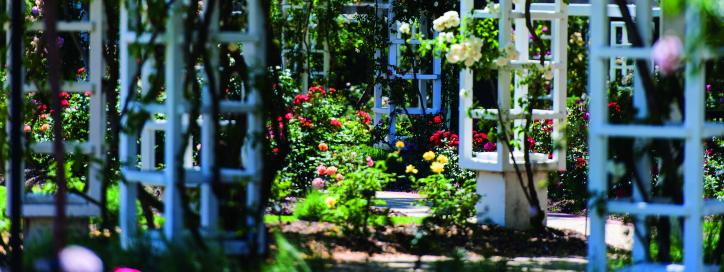
Old Parliament House Gardens: A Heritage in Bloom
About the Gardens
When Parliament first convened in Canberra on 9 May 1927, the city’s landscape was sparse compared to Melbourne’s lush gardens. In those early days, the grounds featured bowling greens, tennis courts, and cricket pitches exclusively for parliamentarians. The transformation began under Robert Broinowski’s vision, supported by Sir Walter Kingsmill and the National Rose Society of New South Wales.
Between 1932 and 1938, despite the hardships of the Depression, these gardens flourished into a stunning display of patterned rose beds and vibrant annuals. Roses were donated by individuals, companies, rose societies, and even members of parliament. For decades, the gardens served as a serene retreat for parliamentarians and their families. Since their reopening in 2004, the Old Parliament House Rose Gardens now welcome all Australians to explore their beauty and discover the stories behind each bloom.
Explore the Gardens
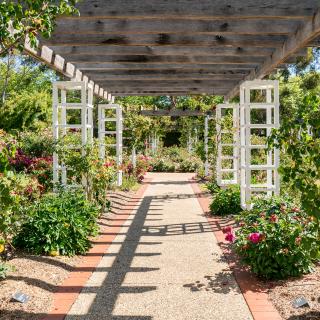
1. Rex Hazelwood Rose Garden
Showcasing centuries-old varieties, this garden celebrates the history of roses. European roses bloom in the west, Asian varieties in the east, with cross-bred roses like Hybrid-Tea and Floribunda uniting the two at the centre.
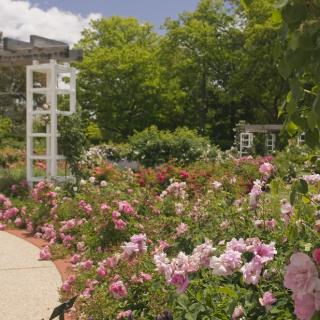
2. Alister Clark Rose Garden
This garden features roses especially bred for Australian conditions by internationally renowned Australian rose breeder, Alister Clark. Look out for blooms like Nancy Heywood and Squatter’s Dream.
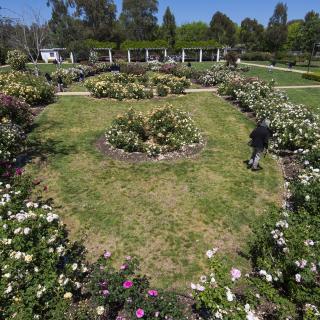
3. Broinowski Rose Garden
Named after then Secretary of the Joint House Department, Robert Broinowski, this garden is filled with English shrub roses, many bred by David Austin, renowned rose breeder. Companion plantings like lavender and delphiniums create the charm of an English country garden.
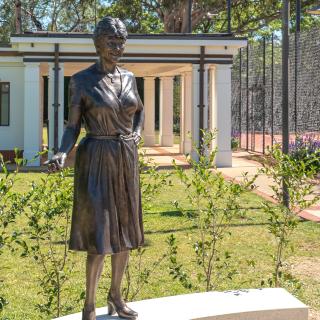
4. Susan Ryan Statue
Located in the Senate rose gardens, this statue celebrates Susan Ryan, the first female senator for the ACT. Her groundbreaking work includes the Sex Discrimination Act 1984 and Affirmative Action Act 1986.
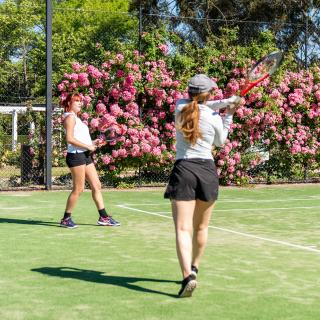
5. Tennis Courts
An original feature of the gardens, the tennis courts are coloured red and green to reflect the Senate and House of representatives.
Once exclusively used by politicians, the courts saw many famous faces over its years in use, such as Bob Hawke and US Vice-
President Bush. Now the courts are now open to everyone and can be booked through Tennis Canberra.
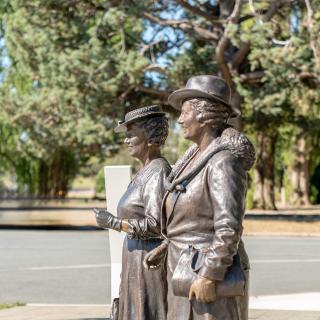
6. Dame Dorothy Tangney and Dame Enid Lyons Sculpture
Dorothy Tangney was Australia’s first female senator and the first Labor woman in Federal Parliament. Enid Lyons was the first woman elected to the House of Representatives and the first appointed to federal Cabinet.
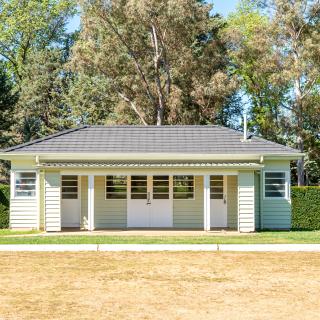
7. Bowling Green and Clubhouse
The bowling green was a popular spot for parliamentary tournaments. Overlooking the green since 1937, the clubhouse remains a nostalgic feature of the gardens.
8. Women’s Suffrage Fountain
The Women’s Suffrage Fountain features a stunning fountain and timeline adorned with a glass mosaic inspired by a wisteria tree. The tile colours reflect those of the women’s suffrage movement, green, white and violet (Give Women the Vote). The timeline highlights significant milestones and achievements of Australian women in Federal Parliament, celebrating their enduring legacy.
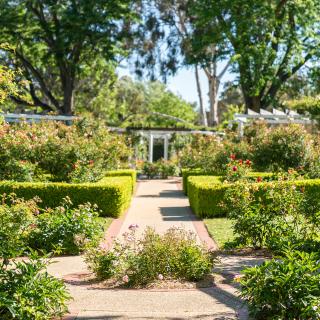
9. Macarthur Rose Garden
A tribute to John Macarthur’s role in the Australian Merino wool industry, this garden includes Etoile de Hollande and Shot Silk roses donated by his great-granddaughter, Rosa Sibella Macarthur-Onslow. Tea roses and Chinese hybrids add to its rich history.
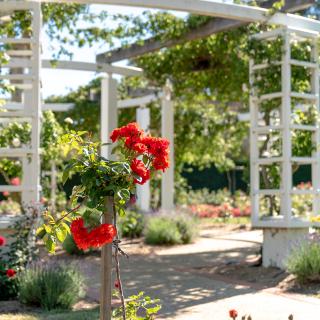
10. Ladies Rose Garden
In the early 1930s at Robert Broinowski’s suggestion, Dame Mary Hughes and Dame Enid Lyons canvassed support from other parliamentary wives to donate funds and contribute roses to establish this garden. During its history much of the garden was taken over for a rubbish tip and squash courts. However, it has been returned to its former glory and now features a range of Hybrid Tea roses and Floribundas, planted in colour groups, red, pink, yellow and white.
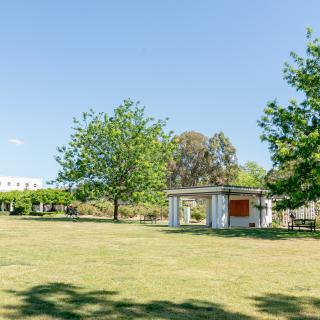
Getting Around
Walking and Running: Accessible entrances are located on all sides of the gardens.
Cycling: Bike racks are available near Old Parliament House, just a short walk away.
Parking: Available at Old Parliament House, Queen Victoria Terrace, Treasury Building, and John Gorton Building, with accessible parking nearby.
Public Transport: Buses stop near the rose gardens. Visit Transport Canberra for route information.
Tips for your visit
Getting There: Drive to Old Parliament House for convenient parking.
Accessibility: While wheelchair accessible, be mindful of uneven surfaces, steps, grass, narrow passes, and pools.
Stay Safe: Wear a hat and sunscreen, especially during the warmer months.
Picnic: Bring along your lunch and eat in the various open spaces through the garden.
- Attractions
- Events
- Education
- Planning
- Planning in the National Capital
- Works Approval
- Heritage
- Heritage Strategy
- Heritage Management Plans
- ANZAC Parade Heritage Management Plan
- Acton Complex Draft Heritage Management Plan
- Australian American Memorial and Sir Thomas Blamey Square Heritage Management Plan
- Blundells Cottage Heritage Management Plan
- Changi Chapel Heritage Management Plan
- Commencement Column Monument HMP
- General Bridges Grave Heritage Management Plan
- High Court – National Gallery Precinct HMP
- King George V Memorial Heritage Management Plan
- Lake Burley Griffin and Adjacent Lands Heritage Management Plan
- National Carillon and Aspen Island Heritage Management Plan
- National Rose Gardens Heritage Management Plan
- Old Parliament House Gardens Heritage Management Plan
- Parliament House Vista Heritage Management Plan
- State Circle Cutting Heritage Management Plan
- Surveyors Hut and Surveyors Park Heritage Management Plan
- York Park Heritage Management Plan
- Heritage Management Plans under consultation
- Heritage Management Plans previous consultations
- Consultations
- Plans, policies and guidelines
- National Capital Plan
- Heritage Management Plans
- Planning Policy Review
- Urban design
- Acton Peninsula Precinct Structure Plan
- City and Gateway Urban Design Framework
- Constitution Avenue Public Realm Handbook
- Creating Places for People and Road User Hierarchy
- Deakin Forrest Residential Precinct Guidelines
- Guidelines for Commemorative Works in the National Capital
- Guidelines for Perimeter Security in the National Capital
- Outdoor Lighting Policy
- Parliamentary Zone Review
- The Griffin Legacy
- Tree Management Policy
- West Basin Precinct Guidelines
- Yarralumla Bay Recreational Hub Master Plan
- Your Capital, Your Say
- Environment
- National Land management
- Asset management
- Lake Burley Griffin
- NCA Projects
- Current NCA Projects
- Past NCA Projects
- Anzac Parade works
- Blundells Cottage Conservation and Interpretation Project
- Boundless Playground Picnic Deck
- Boundless parking extension
- Bowen Place Crossing
- Captain Cook Memorial Jet Upgrade Works
- Car Park Upgrades
- Commonwealth Park Lighting Replacement
- Dame Dorothy Tangney and Dame Enid Lyons Sculpture
- Draft Tree Management Policy
- Dunrossil Drive Pine Tree Replacement
- Furniture upgrade in Commonwealth Park
- High Mast Lighting
- International Flag Display Extension & Lighting Upgrade
- Interpretive Signage in the National Triangle
- John Gorton Building Car Park Upgrade & Associated Works
- John Gorton Building East Car Park Car Park Lighting Replacement Works
- King George V Memorial Works
- Kings Avenue Overpass
- Kings Park Improvements
- Lake Burley Griffin Wall Renewal Program
- Landscape Renewal at the Forecourt of the National Library of Australia
- Merchant Navy War Memorial Upgrade
- National Carillon Upgrade Works
- National Gallery of Australia Foreshore Upgrade
- Old Parliament House Gardens – rose name signage
- Regatta Point Redevelopment
- Restoration Works for the National Emergency Services Memorial
- Scrivener Dam Anchor Bolt Remediation
- Sir John Gorton Sculpture
- Sir John McEwen / National Party of Australia Centenary Commemoration
- Stirling Park improvements (Gura Bung Dhaura)
- Public Interest Certificates
- Parking
- About us
- Who we are
- Our Board
- Our Staff
- Volunteers
- Canberra National Memorials Committee
- History of the NCA
- 1913 - 1920 Walter Burley Griffin, Federal Capital Director of Design and Construction
- 1921 - 1924 Federal Capital Advisory Committee
- 1925 - 1930 Federal Capital Commission
- 1938 - 1957 National Capital Planning and Development Committee
- 1958 - 1989 National Capital Development Commission
- National Capital Planning Committee
- 1989 to Present Day National Capital Authority
- What we do
- Corporate documents
- Careers
- Key Governance Documents
- Video gallery
- Who we are
- Media centre
- Contact us
Acknowledgement of Country
We acknowledge the Ngunnawal people as traditional custodians of the ACT and recognise any other people or families with connection to the lands of the ACT and region.
We acknowledge and respect their continuing culture and the contribution they make to the life of this city and this region.
